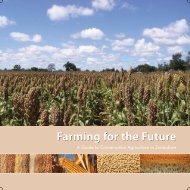Restoring the Soil - Canadian Foodgrains Bank
Restoring the Soil - Canadian Foodgrains Bank
Restoring the Soil - Canadian Foodgrains Bank
You also want an ePaper? Increase the reach of your titles
YUMPU automatically turns print PDFs into web optimized ePapers that Google loves.
58Green Manure/Cover Crop Systems30. Honduras. This photo is not of a handful ofcompost, though it may seem like it is. This is<strong>the</strong> soil of a typical field in <strong>the</strong> maize/mucuna-1system, after planting maize every year for 40years. Without <strong>the</strong> mucuna in this poor tropical soil,a farmer can grow maize for three to four years,and <strong>the</strong>n will have to fallow it for ten to twelveyears. By using mucuna (which can be seen in<strong>the</strong> background of <strong>the</strong> photo), farmers can plantmaize every single year with no loss in productivity.Instead, production gradually increases, up to apoint of diminishing returns at which maize yieldsare about 35% less than those produced on <strong>the</strong>lower-elevation flatlands using hybrids, irrigation,plows, etc.. However, even though <strong>the</strong> productivityis lower, <strong>the</strong> total cost per ton produced is about30% lower than in <strong>the</strong> conventional system,because <strong>the</strong> expenses are so much lower. Thus,<strong>the</strong> maize/mucuna system provides a much largerprofit while operating on less valuable land andincreasing <strong>the</strong> productivity of that land from yearto year.S2. Maize/mucuna-2. This system is usedwest and south of <strong>the</strong> maize/mucuna-1system, where <strong>the</strong>re is less rainfall and adry season occurs from December throughApril. It is used on irrigated land, with <strong>the</strong>mucuna intercropped among <strong>the</strong> maize 30to 40 days after <strong>the</strong> maize is planted. Theearlier planting increases <strong>the</strong> danger of <strong>the</strong>mucuna choking out <strong>the</strong> maize, but <strong>the</strong>later dates reduce <strong>the</strong> organic matter that<strong>the</strong> mucuna will eventually produce. Oftenone pruning is needed to keep <strong>the</strong> mucunafrom covering <strong>the</strong> maize, although thiswill depend on <strong>the</strong> height of <strong>the</strong> maize,how many months <strong>the</strong> maize requires tomature, etc.. Different planting patternsare used; one is to plant three seeds per hillof maize, but only in every o<strong>the</strong>r row. Theplanting seasons depend on <strong>the</strong> supplyof irrigation water. This system seems toonly be used by a few hundred farmers inMexico, and a few o<strong>the</strong>rs in Costa Rica.This system is probably an adaptation ofmaize/mucuna-1 developed by farmers<strong>the</strong>mselves for use in lower-rainfall areas.S3. Maize/jackbean. Jackbean (Canavaliaensiformis) is intercropped with maize ina number of areas of nor<strong>the</strong>rn Yucatanand <strong>the</strong> state of Oaxaca. The jackbean isplanted at <strong>the</strong> same time as <strong>the</strong> maize, withtwo or three seeds per square metre, orsometimes four if <strong>the</strong> weeds are particularlyproblematic. Sword beans (Canavaliagladiatus) can be used in place of <strong>the</strong>jackbean. In Brazil, both jackbean and C.paraguayensis are intercropped with maize. Thousands of farmers in both Mexico andBrazil use this traditional system. For this system, use only <strong>the</strong> bushy-type jackbean,not <strong>the</strong> climbing type.S4. Maize/lima bean. Lima beans (Phaseolus lunatus), locally called “ibes,” are intercroppedwith maize on <strong>the</strong> Yucatan Peninsula. The beans produced are, of course,eaten. The lima beans are planted ei<strong>the</strong>r toge<strong>the</strong>r with <strong>the</strong> maize or up to a monthafterwards. Tens of thousands of farmers are using this traditional system. A similarsystem is used in western Guatemala (where <strong>the</strong> lima bean is called “piligua”) andsou<strong>the</strong>rn Honduras (where it is called “chilipuca”).
















